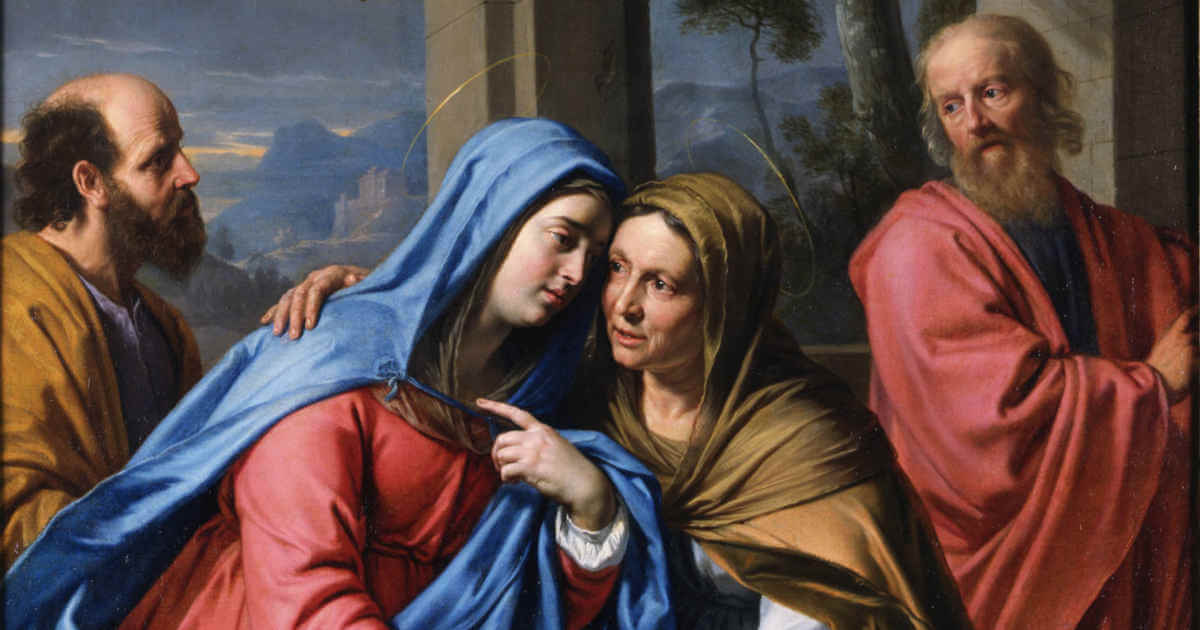THE HIDDENESS OF MARY (continued)
THE HIDDENESS OF
MARY (continued)
This is the follow-up to my
article last week on the Blessed Virgin Mary.
I promised to provide more commentary on some Marian texts with the hope
of showing that the New Testament does, in fact, give Mary a prominent role in
God’s plan for the salvation of the world.
Let us consider Mary’s visit to
Elizabeth. The angel Gabriel had told her
that her cousin Elizabeth, who was without child, had conceived a son in her
old age and was due in three months. After
the angel left, Mary “made haste” to visit her cousin “in the hill country, to
a city of Judah.” When she greeted Elizabeth
the babe, later known as John the Baptist, leaped in her womb. The precursor of the Messiah leaped for joy
on hearing Mary’s voice and was consecrated in the womb. Elizabeth said, “And why is this granted to me, that the
mother of my Lord should come to me?” (Lk 1:43). Mary responded
by singing a canticle, which we call the Magnificat according to its first word
in Latin: Magnificat anima mea Dominum. “My soul proclaims the greatness of the Lord;
my spirit rejoices in God my savior. For
he has looked upon his handmaid’s lowliness; behold, from now on, all ages will
call me blessed. The Mighty One has done
great things for me, and holy is his name.” (Lk 1:46-49).
The Magnificat is sung every
evening in Vespers, the Church’s official Evening Prayer. Clearly it was God’s plan that all
generations call her blessed and remember the great things that he did for
her. By including this canticle every
evening the Church seeks to remember and honor Mary. She keeps before the Church and the world the
humanity of Christ, who had a true mother.
The Church also presents Mary as a model of prayer. She begins with praise and gratitude, acknowledges
her personal humility, and exalts in what God has done for her. She lauds God’s mercy towards all who fear him
and celebrates his victory over the powerful.
She affirms that God will cast down the mighty and lift up the lowly and
will never forget his promise to Israel.
Among all the Saints Mary is the only one who is officially honored and
remembered every day, in the Mass, in Vespers, and at the conclusion of
Compline (Night Prayer). She is also
remembered every day by many faithful, especially in their Rosaries and the
Angelus prayer.
St. Luke records that the
shepherds outside of Bethlehem, watching over their sheep at night, were
informed by an angel of the birth of “a Savior, who is Christ the Lord.” They ran to Bethlehem “and found Mary and
Joseph, and the baby lying in a manger.”
It is interesting that Mary is mentioned first. Twelve years later it is Mary, not Joseph,
who reprimands Jesus after she and Joseph spent three days looking for him in
Jerusalem: “Son, why have you treated us so?
Behold, your father and I have been looking for you anxiously” (Lk 2:48). Both after the incidence with the shepherds
and the finding of Jesus in the Temple Luke notes that Mary “kept all these
things in her heart.” Some scholars
suggest that this may be an indication that Mary herself related these events
to Luke.
Mary is a key figure for Luke
although she is not always by Jesus’ side during his public ministry. I think it is significant that when he writes
the Acts of Apostles, he places her as present in the Upper Room with the
eleven disciples and some other women shortly before Pentecost. As she was there at the beginning, Mary will
always be a prayer support in the Church.
Throughout the centuries our blessed Mother Mary has gathered people to
pray. Like all Christian mothers, she is
Mother of the Church, who teaches her children to pray and to love her Son.
Let me close this reflection with
a brief consideration of Mary at the foot of the Cross, as given to us in the
Gospel of John. Jesus looks at her from
the Cross and says, “Woman, behold your son.” He then looks at the “beloved
disciple” (the apostle John) and says, “Behold, your Mother.” John records, “And from that hour the
disciple took her to his own home” (Jn 19:26-27). This is
truly significant, not to be lightly passed over. It is one of the last acts of Jesus before he
dies. In fact, we did not choose Mary. Jesus gave her to us, by entrusting her to
his “beloved disciple,” the one whom he loved above the others, and who at the
foot of the Cross represented all the faithful who would become his beloved by
faith and love. He received Mary
immediately into his home, as do we, welcoming her into our hearts as the
spiritual Mother whom Jesus knows we need.
Hail, full of grace!




Comments
Post a Comment